Deck 13: Urbanization and Urban Networks
Question
Question
Question
Question
Question
Question
Question
Question
Question
Question
Question
Question
Question
Question
Question
Question
Question
Question
Question
Question
Question
Question
Question
Question
Question
Question
Question
Question
Question
Question
Question
Question
Question
Question
Question
Question
Question
Question
Question
Question

Unlock Deck
Sign up to unlock the cards in this deck!
Unlock Deck
Unlock Deck
1/40
Play
Full screen (f)
Deck 13: Urbanization and Urban Networks
1
Division of labor refers to
A)jobs divided up by race.
B)working harder than ever before in factory jobs.
C)people working in specific jobs according to need.
D)more and more agricultural jobs available.
A)jobs divided up by race.
B)working harder than ever before in factory jobs.
C)people working in specific jobs according to need.
D)more and more agricultural jobs available.
C
2
Up until a few thousand years ago, cities
A)did not exist.
B)were only found in Japan and China.
C)clustered in Mexico and Central America only.
D)were always widely spread globally.
A)did not exist.
B)were only found in Japan and China.
C)clustered in Mexico and Central America only.
D)were always widely spread globally.
A
3
During the Middle Ages which is an example of developing city functions?
A)iron being developed to improve tools like axes and plows
B)a highly developed road network connecting the Roman Empire
C)bankers in cities helping to underwrite commercial and artisan activities
D)more remote cultures being subdued by the dominant political power at the time
A)iron being developed to improve tools like axes and plows
B)a highly developed road network connecting the Roman Empire
C)bankers in cities helping to underwrite commercial and artisan activities
D)more remote cultures being subdued by the dominant political power at the time
C
4
In the Middle Ages two main axes of trade were
A)Central France and Central Spain.
B)Southern England and coastal Flanders.
C)the Baltic Hanseatic League and Italian port cities.
D)the Greek culture area from Turkey through southern Italy
A)Central France and Central Spain.
B)Southern England and coastal Flanders.
C)the Baltic Hanseatic League and Italian port cities.
D)the Greek culture area from Turkey through southern Italy

Unlock Deck
Unlock for access to all 40 flashcards in this deck.
Unlock Deck
k this deck
5
World areas with no urban development before the year AD 0 would be
A)Europe.
B)North America.
C)Australia.
D)all of the above. Scrambling: Locked
A)Europe.
B)North America.
C)Australia.
D)all of the above. Scrambling: Locked

Unlock Deck
Unlock for access to all 40 flashcards in this deck.
Unlock Deck
k this deck
6
Iron enabled
A)better plows to be made.
B)better axes to clear woodland.
C)a concentrated industry in towns and cities.
D)all of the above. Scrambling: Locked
A)better plows to be made.
B)better axes to clear woodland.
C)a concentrated industry in towns and cities.
D)all of the above. Scrambling: Locked

Unlock Deck
Unlock for access to all 40 flashcards in this deck.
Unlock Deck
k this deck
7
In Chang An, China a city was built based on
A)the combination of circles and triangles drawn on the land.
B)long lots giving access to the local river.
C)squares that were nearly exactly one square mile by one square mile.
D)a well-developed rectilinear pattern.
A)the combination of circles and triangles drawn on the land.
B)long lots giving access to the local river.
C)squares that were nearly exactly one square mile by one square mile.
D)a well-developed rectilinear pattern.

Unlock Deck
Unlock for access to all 40 flashcards in this deck.
Unlock Deck
k this deck
8
On the map of trade routes in the Middle Ages the green lines signify ____________ while the purple lines are __________________. 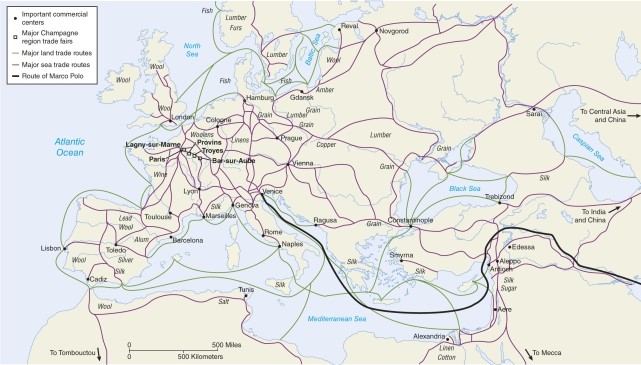
A)political boundaries;cultural watersheds
B)mountainous physical boundaries;railroads
C)sea routes;land routes
D)German roads;Roman roads

A)political boundaries;cultural watersheds
B)mountainous physical boundaries;railroads
C)sea routes;land routes
D)German roads;Roman roads

Unlock Deck
Unlock for access to all 40 flashcards in this deck.
Unlock Deck
k this deck
9
After the Roman Empire the entire basis for civilization was swept away when
A)the Roman city and highway network was obliterated.
B)Germanic tribes from the north invaded the Roman territories.
C)isolated communities no longer were connected to Roman power.
D)all of the above. Scrambling: Locked
A)the Roman city and highway network was obliterated.
B)Germanic tribes from the north invaded the Roman territories.
C)isolated communities no longer were connected to Roman power.
D)all of the above. Scrambling: Locked

Unlock Deck
Unlock for access to all 40 flashcards in this deck.
Unlock Deck
k this deck
10
Urban networks tied together in some meaningful way refers directly to
A)hinterland origins.
B)core-periphery relations.
C)environmental determinism.
D)functional linkages.
A)hinterland origins.
B)core-periphery relations.
C)environmental determinism.
D)functional linkages.

Unlock Deck
Unlock for access to all 40 flashcards in this deck.
Unlock Deck
k this deck
11
The Franks, the Burgundians, the Ostrogoths, and the Vandals were all
A)Roman groups speaking Latin languages (or what Latin developed into).
B)mainland north European groups that moved into the British Isles.
C)non Indo-European groups that moved northward post-Empire.
D)Germanic groups generally moving southward post-Empire.
A)Roman groups speaking Latin languages (or what Latin developed into).
B)mainland north European groups that moved into the British Isles.
C)non Indo-European groups that moved northward post-Empire.
D)Germanic groups generally moving southward post-Empire.

Unlock Deck
Unlock for access to all 40 flashcards in this deck.
Unlock Deck
k this deck
12
One main reason for the development of cities from villages was that food
A)tended to be perishable so people had to stay in one place.
B)was available in surplus which increased town growth.
C)was disseminated over wide areas inhibiting growth.
D)simply was not available in large amounts.
A)tended to be perishable so people had to stay in one place.
B)was available in surplus which increased town growth.
C)was disseminated over wide areas inhibiting growth.
D)simply was not available in large amounts.

Unlock Deck
Unlock for access to all 40 flashcards in this deck.
Unlock Deck
k this deck
13
In the Roman Empire, roads connected cities in a network
A)spreading from Spain to Romania.
B)that was mainly in the Italian peninsula, but not elsewhere.
C)that concentrated in Greece more than in Italy.
D)caused the development of Paris as the leading European city.
A)spreading from Spain to Romania.
B)that was mainly in the Italian peninsula, but not elsewhere.
C)that concentrated in Greece more than in Italy.
D)caused the development of Paris as the leading European city.

Unlock Deck
Unlock for access to all 40 flashcards in this deck.
Unlock Deck
k this deck
14
Rome was about 1 million people by 150 AD showing that
A)agriculture supported cities but not very well.
B)even some early capitals of empires grew very large.
C)the city had to develop along long lots.
D)the French were very influential in city development.
A)agriculture supported cities but not very well.
B)even some early capitals of empires grew very large.
C)the city had to develop along long lots.
D)the French were very influential in city development.

Unlock Deck
Unlock for access to all 40 flashcards in this deck.
Unlock Deck
k this deck
15
The first area to develop cities was
A)the Indus River Valley.
B)China.
C)the Fertile Crescent region, or Sumeria.
D)the Aztec region of Central America.
A)the Indus River Valley.
B)China.
C)the Fertile Crescent region, or Sumeria.
D)the Aztec region of Central America.

Unlock Deck
Unlock for access to all 40 flashcards in this deck.
Unlock Deck
k this deck
16
Areas of urban development later, around the year AD 0 would have been in
A)what is today the Middle East.
B)what is today China.
C)what is today Central and northern South America.
D)what is today Southeast Asia.
A)what is today the Middle East.
B)what is today China.
C)what is today Central and northern South America.
D)what is today Southeast Asia.

Unlock Deck
Unlock for access to all 40 flashcards in this deck.
Unlock Deck
k this deck
17
Which of the following applies to the definition of urbanization?
A)the access to cities of rural farmer's goods
B)the developments of ports in polar regions
C)increasing percentages of people living in cities
D)the dwindling occupation of cities due to diseases like the bubonic plague
A)the access to cities of rural farmer's goods
B)the developments of ports in polar regions
C)increasing percentages of people living in cities
D)the dwindling occupation of cities due to diseases like the bubonic plague

Unlock Deck
Unlock for access to all 40 flashcards in this deck.
Unlock Deck
k this deck
18
In Sumeria, smaller city-states gradually developed into
A)larger territorial states.
B)elongated states like Vietnam or Chile.
C)more city-states.
D)empires.
A)larger territorial states.
B)elongated states like Vietnam or Chile.
C)more city-states.
D)empires.

Unlock Deck
Unlock for access to all 40 flashcards in this deck.
Unlock Deck
k this deck
19
The area surrounding a city from which it obtains food is called
A)a hinterland.
B)a suburb.
C)an exurb.
D)a river valley.
A)a hinterland.
B)a suburb.
C)an exurb.
D)a river valley.

Unlock Deck
Unlock for access to all 40 flashcards in this deck.
Unlock Deck
k this deck
20
With the development of agriculture, settlements occurred when
A)people settled permanently in one place.
B)people developed many new diseases and could not move.
C)animals could no longer be moved from place to place.
D)migration met obstacles like large rivers or mountains.
A)people settled permanently in one place.
B)people developed many new diseases and could not move.
C)animals could no longer be moved from place to place.
D)migration met obstacles like large rivers or mountains.

Unlock Deck
Unlock for access to all 40 flashcards in this deck.
Unlock Deck
k this deck
21
Putting much data together, the three most influential cities in the world economically are probably
A)Los Angeles, Madrid, and Hong Kong.
B)Rome, Bombay, and Sydney.
C)Chicago, Berlin, and Moscow.
D)New York, London, and Tokyo.
A)Los Angeles, Madrid, and Hong Kong.
B)Rome, Bombay, and Sydney.
C)Chicago, Berlin, and Moscow.
D)New York, London, and Tokyo.

Unlock Deck
Unlock for access to all 40 flashcards in this deck.
Unlock Deck
k this deck
22
Over time the percent of population on the urbanization curve
A)generally increases.
B)generally decreases.
C)stays about the same.
D)none of the above. Scrambling: Locked
A)generally increases.
B)generally decreases.
C)stays about the same.
D)none of the above. Scrambling: Locked

Unlock Deck
Unlock for access to all 40 flashcards in this deck.
Unlock Deck
k this deck
23
Though the city of Akron, Ohio was once king in the tire industry much of that has ceased to exist and the city is now trying to diversify and focus on polymers.This shows that
A)cities may shift their functions over time according to need.
B)all cities move gradually from more industrial pursuits to more service oriented ones.
C)most cities will always have a focus on automobile parts or production.
D)once the function of a city is set, it cannot change to some other function.
A)cities may shift their functions over time according to need.
B)all cities move gradually from more industrial pursuits to more service oriented ones.
C)most cities will always have a focus on automobile parts or production.
D)once the function of a city is set, it cannot change to some other function.

Unlock Deck
Unlock for access to all 40 flashcards in this deck.
Unlock Deck
k this deck
24
On the graph of growth of British cities during the 1800s, the rising lines represent 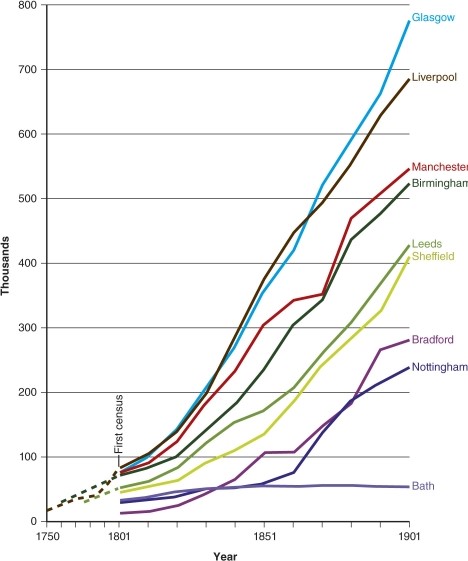
A)increasing agricultural capacity.
B)increasing market sales.
C)decreasing road network density.
D)increasing city population.

A)increasing agricultural capacity.
B)increasing market sales.
C)decreasing road network density.
D)increasing city population.

Unlock Deck
Unlock for access to all 40 flashcards in this deck.
Unlock Deck
k this deck
25
Different countries go through the urbanization process at different times.The chart clearly shows which region urbanizing earlier after onset of urbanization? 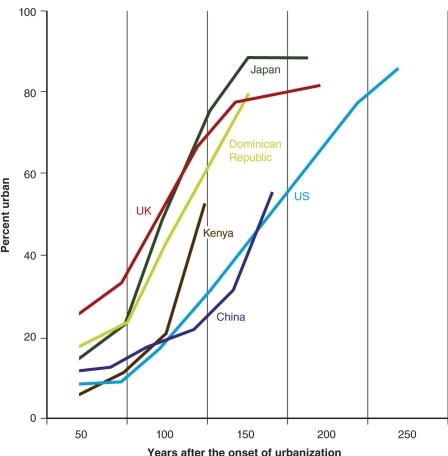
A)Kenya
B)China
C)the U.K.
D)the U.S.

A)Kenya
B)China
C)the U.K.
D)the U.S.

Unlock Deck
Unlock for access to all 40 flashcards in this deck.
Unlock Deck
k this deck
26
Though India is large with a large population (world's second largest) its percent urban population is 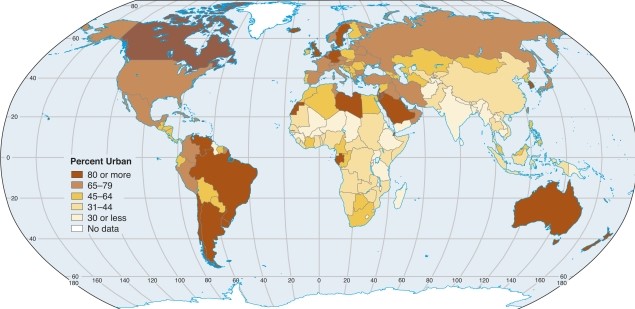
A)in the lowest colored category on this map.
B)lower than one would expect considering overall development there.
C)about the same as that of Europe.
D)both a and b are true. Scrambling: Locked

A)in the lowest colored category on this map.
B)lower than one would expect considering overall development there.
C)about the same as that of Europe.
D)both a and b are true. Scrambling: Locked

Unlock Deck
Unlock for access to all 40 flashcards in this deck.
Unlock Deck
k this deck
27
Many early factories developed around places where raw materials were mined like
A)copper in Bingham Canyon, Utah.
B)coal in central Pennsylvania.
C)rivers in Kentucky and Indiana.
D)port cities like Boston or New Orleans.
A)copper in Bingham Canyon, Utah.
B)coal in central Pennsylvania.
C)rivers in Kentucky and Indiana.
D)port cities like Boston or New Orleans.

Unlock Deck
Unlock for access to all 40 flashcards in this deck.
Unlock Deck
k this deck
28
Which of the following is not a function of many cities today?
A)a market
B)an administrative or political center
C)an influential agricultural region
D)a place of significant manufacturing
A)a market
B)an administrative or political center
C)an influential agricultural region
D)a place of significant manufacturing

Unlock Deck
Unlock for access to all 40 flashcards in this deck.
Unlock Deck
k this deck
29
According to the map of world percent urbanization which country is the most urbanized? 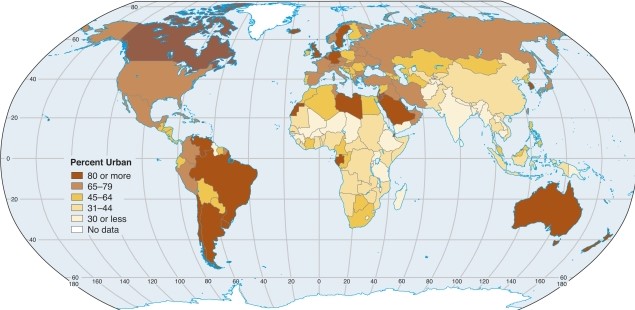
A)China
B)Japan
C)North Korea
D)South Korea

A)China
B)Japan
C)North Korea
D)South Korea

Unlock Deck
Unlock for access to all 40 flashcards in this deck.
Unlock Deck
k this deck
30
The chart showing urban hierarchies shows generally that 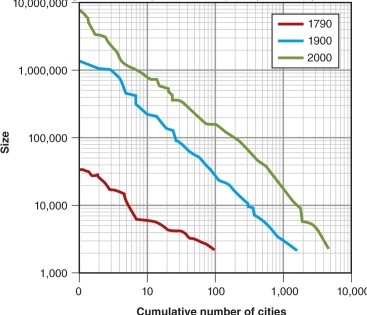
A)as the number of cities in a region or country increases, their size decreases.
B)many cities in a country are usually representative of that country's total culture.
C)many cities in a country have national political duties as capitals.
D)none of the above. Scrambling: Locked

A)as the number of cities in a region or country increases, their size decreases.
B)many cities in a country are usually representative of that country's total culture.
C)many cities in a country have national political duties as capitals.
D)none of the above. Scrambling: Locked

Unlock Deck
Unlock for access to all 40 flashcards in this deck.
Unlock Deck
k this deck
31
Which city could be seen as extra specialized in its functions and not like the rest?
A)Cleveland, Ohio
B)Pittsburgh, Pennsylvania
C)Detroit, Michigan
D)Las Vegas, Nevada
A)Cleveland, Ohio
B)Pittsburgh, Pennsylvania
C)Detroit, Michigan
D)Las Vegas, Nevada

Unlock Deck
Unlock for access to all 40 flashcards in this deck.
Unlock Deck
k this deck
32
According to the table, cities like Chicago or Birmingham are known for 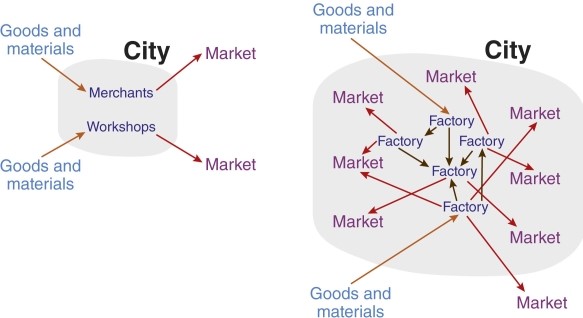
A)textiles.
B)primary metals.
C)hotel industries.
D)food and beverages.

A)textiles.
B)primary metals.
C)hotel industries.
D)food and beverages.

Unlock Deck
Unlock for access to all 40 flashcards in this deck.
Unlock Deck
k this deck
33
Regarding percent urbanized in population which is true regarding Australia and New Zealand?
A)they have generally high populations in total numbers
B)they have generally low percent urbanized populations
C)though they are very urbanized, their total populations are low
D)all of the above Scrambling: Locked
A)they have generally high populations in total numbers
B)they have generally low percent urbanized populations
C)though they are very urbanized, their total populations are low
D)all of the above Scrambling: Locked

Unlock Deck
Unlock for access to all 40 flashcards in this deck.
Unlock Deck
k this deck
34
According to the map of world urban percentages, the area that is the least urbanized is 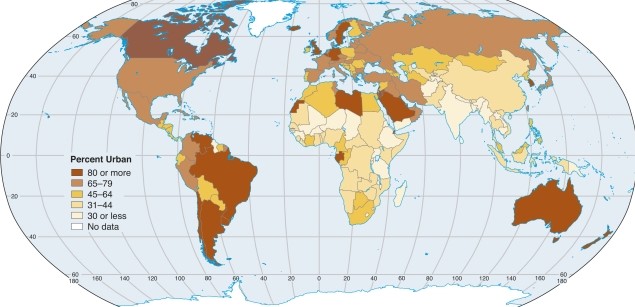
A)North America.
B)Europe.
C)Australia.
D)Africa.

A)North America.
B)Europe.
C)Australia.
D)Africa.

Unlock Deck
Unlock for access to all 40 flashcards in this deck.
Unlock Deck
k this deck
35
According to the table, which of the following have specializations in textiles and are located in the American South? 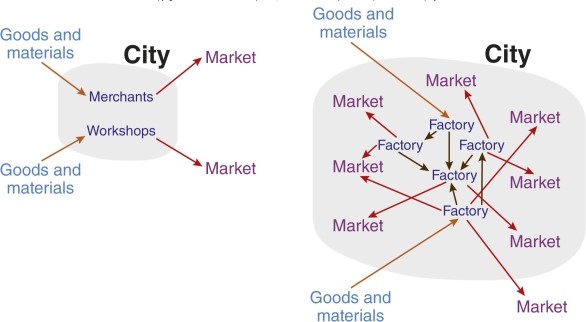
A)Las Vegas, Los Angeles, and Tucson
B)Charlotte, Charleston, and Richmond
C)Denver, Salt Lake City, and Albuquerque
D)Indianapolis, Columbus, and St.Louis

A)Las Vegas, Los Angeles, and Tucson
B)Charlotte, Charleston, and Richmond
C)Denver, Salt Lake City, and Albuquerque
D)Indianapolis, Columbus, and St.Louis

Unlock Deck
Unlock for access to all 40 flashcards in this deck.
Unlock Deck
k this deck
36
The industrial revolution also changed agriculture in that
A)hinterlands began to shrink.
B)road networks began to disintegrate.
C)the automobile made cities excessively large.
D)a system of open fields shifted to one of fields divided by stone fences and hedgerows.
A)hinterlands began to shrink.
B)road networks began to disintegrate.
C)the automobile made cities excessively large.
D)a system of open fields shifted to one of fields divided by stone fences and hedgerows.

Unlock Deck
Unlock for access to all 40 flashcards in this deck.
Unlock Deck
k this deck
37
On the map of world urban percentages, the darkest brown color (at the top of the map legend) represents 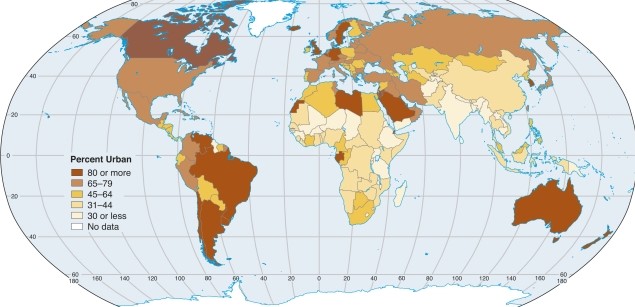
A)the highest percentage urban.
B)the dirtiest cities.
C)generally lower percentages.
D)regions with the largest cities.

A)the highest percentage urban.
B)the dirtiest cities.
C)generally lower percentages.
D)regions with the largest cities.

Unlock Deck
Unlock for access to all 40 flashcards in this deck.
Unlock Deck
k this deck
38
Agglomeration activities
A)allow cities to focus heavily on different types of functions.
B)make cities stick together like glue.
C)tend to develop city states, breaking cities away from larger political units.
D)are politically more appealing to conservative presidential candidates.
A)allow cities to focus heavily on different types of functions.
B)make cities stick together like glue.
C)tend to develop city states, breaking cities away from larger political units.
D)are politically more appealing to conservative presidential candidates.

Unlock Deck
Unlock for access to all 40 flashcards in this deck.
Unlock Deck
k this deck
39
The urban population map of France shows that 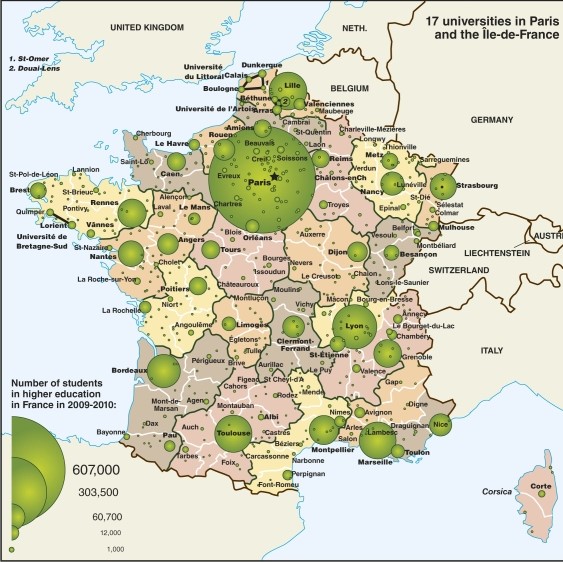
A)many cities are equally important culturally and economically in the country.
B)no one city is dominant in France.
C)the main city in influence, without doubt, is Paris.
D)Marseilles and Lyon together just about equal Paris in strength and influence.

A)many cities are equally important culturally and economically in the country.
B)no one city is dominant in France.
C)the main city in influence, without doubt, is Paris.
D)Marseilles and Lyon together just about equal Paris in strength and influence.

Unlock Deck
Unlock for access to all 40 flashcards in this deck.
Unlock Deck
k this deck
40
Mass production required
A)concentrated settlement at a few places.
B)agriculture widely spread across the countryside.
C)initially, many northern Italians.
D)none of the above. Scrambling: Locked
A)concentrated settlement at a few places.
B)agriculture widely spread across the countryside.
C)initially, many northern Italians.
D)none of the above. Scrambling: Locked

Unlock Deck
Unlock for access to all 40 flashcards in this deck.
Unlock Deck
k this deck



